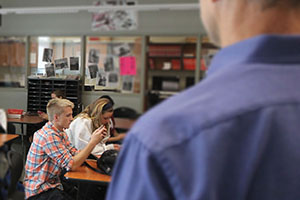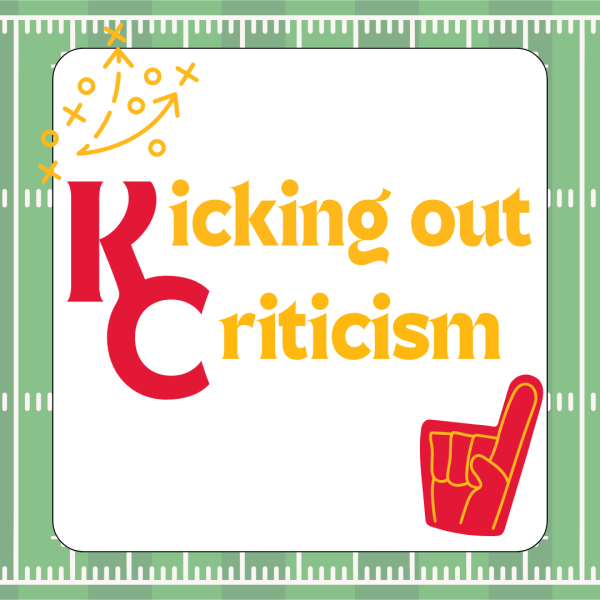Digital Distractions

Sitting in a 50-minute class at a high school, it’s pretty easy to pick up on the difference between students who actually want to learn and the students who are there because they’re legally obligated. The kid who is at least trying to learn is sitting there and diligently listening, while that student’s counterpart is texting and has an ear-bud in all class. Cell phones are becoming a distraction in our schools, and the line needs to be drawn on uses of cell phones in the classroom.
Early last month, Apple unveiled its newest creations, the iPhones 5s and 5c. A survey done by Piper Jaffray shows that that nearly half of all American teenagers own an iPhone. Their most popular product is basically treated as a toy by teenagers.Teens have become so attached to their phones, that they’re not able to go anywhere, or do anything without it in pocket. There are actually a multitude of ways cell phones can be used for beneficial purposes in class. Programs that allow students to interact with the learning material are abundant in this day and age. There are websites that allow students to record responses to a quiz on their phone by texting in their answers like the polling program, Pole Everywhere. StudentVue has a smartphone application that allows students to check their grades easily at school.
Students today, however, are seemingly addicted to their cell phones. The South Korean government has set up a program to help heal teenager’s in their country with their cell phone addictions. While there are limitless ways cell phones could be used in beneficial ways in school, these addictions to smartphones don’t exactly yield when it comes time for class. A teacher may mention a cell phone policy at the beginning of the year, but he or she rarely enforces it. The teachers that put the hammer down with a strict no-cellphone policy at the beginning of the year rarely have issues with students looking at their phones instead of the whiteboard.
The fear of cheating is one of the main reasons some teachers have been cracking down on inappropriate cell phone use in class.
“I’ve been involved in several instances of cheating,” English Language Arts teach Katherine Buchanan said. “Students would take a picture of a test and then put it on Twitter.”
“Cell phones could definitely be used more appropriately in class,”science teacher Deborah Sisk said. “Teachers have really been trying to engage students in more purposeful uses for smartphones.”
Resources like phone applications are certainly great learning tools. Apps like Dropbox and Evernote allow students to log the information they learn in class and study it later on computers at home. These are all great ways smart phones can be used in class; however, it all comes back to the maturity issue. Students can be told to look something up on their phone, but instead use this opportunity to be on their phones to text their friend or to try to beat their high score on a game.
Schools worldwide also struggle with having students addicted to their phones. A high school in Bondurant, Iowa, has banned students having their cell phones out in class. This may sound extreme, but school officials claim that the students were using the phones excessively, and something needed to be done. In countries in Asia, it is common practice for teachers to take the students phones during class hours. In Germany the rules aren’t much different.
“In Germany, if a teacher sees you with a phone out they will immediately take it away,” German foreign exchange student Alexander Hintz said.
Some students are opposed to the fact that teachers have the right to confiscate students’ phones. They believe they have the right to use to their cell phones in class without the fear of getting their phones taken away.
“Teachers need to be more lenient with their phone policies,” sophomore Zach Keeling said. “Some teachers I respect for being more lenient because they understand that phones are a common part of daily life.”Students and teachers, however, are expected to follow the student technology guidelines set forth by the Blue Valley School District, which clearly states that cell phones and other personal mobile electronics are to be used for educational purposes only. Students need to expect confiscation of their cell phones if they abuse their privileges.
A University of Pittsburgh study shows that students send an average of 2.6 texts per class, and are more likely to miss instruction and score lower grades as a result. Having your phone out in class and texting distract you from listening to the instructor and learning the class material.
Technology is a great thing; there is no denying. Teenagers need to be able to separate themselves from their phones, especially when there is a teacher standing at the front of the room teaching. I think everybody has sent the occasional text during class, and that’s not an issue. The issue is when you distract yourself from learning during class by constantly staring at your phone screen. Our society has gone decades without such technology, and we should be able to go 50 minutes without it.







